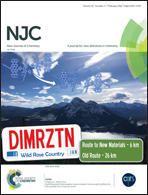Enhanced activity of trinuclear Zn(ii) complexes towards phosphate ester bond cleavage by introducing three-metal cooperativity†
Abstract
Three Zn(II) complexes, namely, [Zn3(L1)2]·4CH3CN (1), [Zn3(L1)2(H2O)4]·H2O·2DMF (2) and [Zn2(L2)2·(H2O)2·2H+]·2ClO4− (3) were synthesized by reacting nitrophenol-based tripodal and dipodal Schiff-base ligands with Zn(II) salts. The complexes were characterized using different techniques such as elemental analyses, ESI-MS, IR and NMR. The solid-state structures of all the complexes were determined. Complex 1 has a rigid trinuclear structure with an octahedral environment around each metal ion. The coordination environment of the rigid trinuclear complex 1 was purposely disturbed by changing the reaction conditions to obtain the flexible trinuclear complex 2. The dinuclear complex 3, containing coordinated water molecules, was also synthesized. DNA binding abilities and phosphatase-like activities of all the complexes were investigated. The catalytic activity of the rigid trinuclear complex 1 was compared with the cup shaped trinuclear complex 2 and closed structure dinuclear complex 3. The different structural factors (such as flexibility of the complex, number of metal centers, labile sites at the metal centre and coordination environment around the metal center) collectively modulate the phosphatase-like activity toward the transesterification of 2-hydroxypropyl-p-nitropenylphosphate (HPNP). Complex 2 exhibits the highest catalytic activity among all the complexes due to its flexible cup-shaped structure, three metal centers and coordinated water molecules.



 Please wait while we load your content...
Please wait while we load your content...